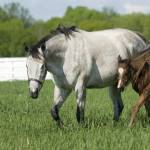Effect of Birth Month on Size and Weight Gain in Thoroughbred Foals

In a three-year study conducted by Kentucky Equine Research in the early 1990s, 350 Thoroughbred colts and 350 Thoroughbred fillies in central Kentucky were weighed monthly on a portable electronic scale through 18 months of age. The foals were divided into four groups based on the month that they were born. These groups consisted of January and February foals (16.9%), March foals (35.7%), April foals (32.5%) and May and June foals (21.4%)
Compared to March foals, those born in January and February were 6.8 kg (15 lb) lighter at 14 days of age. They remained smaller, by as much as 15.3 kg (34 lb) at 72 days of age, until about nine months of age when they averaged about the same as the March foals. April and May foals were larger at 14 days of age than March foals, and remained slightly heavier until six months of age. Average daily gain (ADG) among the four groups was similar until about seven months of age. ADG averaged 1.6 kg/d (3.5 lb/d) during the first month and declined linearly to about 0.75 kg/d (1.6 lb/d) at seven months of age. After this age, ADG tended to be more variable and by 12 months, ADG was very different among the different groups. This variability can be explained, however, by the season of the year in which each group reached a particular age. Foal growth rates were reduced during the winter months regardless of when the foals were born, and increased during April and May of the foal’s yearling year. Growth rates during these months were remarkably similar regardless of age. Each group of foals experienced their slowest growth during January, February, and March. During the spring months of April and May, each group of foals increased their ADG, with peak gains occurring in May.
These data clearly demonstrate that growth rate in these yearlings is more a function of season of the year than age. Growth rate closely follows changes in temperature and pasture growth in Kentucky. Most foals in Kentucky are raised in large paddocks with a great deal of available forage. During April and May, pasture growth is quite rapid. Supplemental grain intake is generally not greatly reduced during this time and growth rate accelerates as a result of increased caloric intake from forage. Assuming that grain intake remains constant and pasture contains about 9.2 MJ DE/kg DM, then these yearlings would need to consume about 3.25 additional kg ( (7.15 lb) of pasture DM per day in May to increase their ADG from 0.35 kg (0.75 lb) during the winter to about 0.8 kg/d (1.8 lb/d). This increase in dry matter intake would equal about 0.75%-1.0% of BW per day.
A comparison was made for body weight and height between Kentucky foals and Canadian foals born in March. Kentucky foals were slightly taller (101.2%) and heavier (102.0 %) at 14 days of age. From six to nine months of age, the Kentucky foals grew from 1.7 to 3.0 cm (0.75-1.25 in) taller. These foals were also heavier from four to ten months of age. At six months of age, the Kentucky foals averaged 107.2 % of the Canadian body weight. By 12 months of age, the two groups had similar heights and weights. The Kentucky foals became heavier at 15 and 16 months, the age that coincided with rapid spring pasture growth in Kentucky.
The difference in body weights seen between these two groups of March foals could be the result of several factors. First, the foals in Canada were weaned at three months of age while Kentucky foals are not usually weaned until they are five to six months old. These foals therefore had access to milk as well as grain and pasture for a longer period of time. At six months of age, March foals in Kentucky have access to high-quality fall pasture. This forage often remains lush and abundant until November when the foals are ten months of age. Fall pasture in Ontario is not as abundant and temperatures begin to drop much earlier than in Kentucky.
Results of this study showed that Thoroughbred foals raised in Kentucky grew faster from four to nine months of age than foals raised in Ontario, Canada. These differences in growth were probably related to a later weaning time and abundant fall pasture in Kentucky compared to Canada. By 12 months of age, height and weight differences between the two groups had disappeared. Since rapid growth and excess body weight have been implicated as possible causes of skeletal disorders in foals, this extra growth in the Kentucky foals during the fall months is probably not desirable. Extra weight gain could be controlled by earlier weaning and by reducing supplemental grain intake as pasture becomes more available. Monthly weight monitoring can be used to signal the onset of this excessive weight gain.
Average daily gain in yearlings was affected more by season than age. All of the foals experienced accelerated growth in the spring as pasture growth increased. Again, this accelerated growth can be identified by regular weighing and controlled by reductions in supplemental grain intake.








